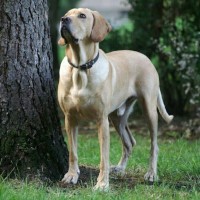 |
American Gointer |
|
He is not recognized by the F.C.I. |
Origin |
Great Britain -> U.S.A. | |
Translation |
Francis Vandersteen |
A brief presentation of the American Gointer |
| The American Gointer is a hybrid breed developed by crossing the Golden Retriever and the English Pointer. Although the breed's origins are not well known, Golden Retrievers are well documented to have originated in Scotland, where they were bred from various hunting dogs in the 1800s. English Pointers were developed in England a century earlier from Spanish Pointers brought by English officers. The American Gointer combines the hunting characteristics of both dogs to create a proportionally full-bodied, active and affectionate companion. The Gointer is a loyal and loving member of the family, requiring minimal care and plenty of exercise. It's an energetic dog that will follow you anywhere, camping, hiking or even swimming. |
History of the American Gointer |
| The American Gointer is a cross between the Golden Retriever and the English Pointer. Little is known about the Gointer's early origins, and as they are a modern hybrid, they are not recognized by the AKC. While many Gointers are a 50/50 mix, there are breeders who breed these hybrids over several generations, which can vary the amounts of each pure breed in a given puppy. |
A little of the Golden Retriever |
||
| While Pointers were being developed in England, their neighbors in Scotland developed the Golden Retriever in the early 1800's. They were bred from a yellow wavy-coated Retriever and a Water Spaniel by Lord Tweedmouth, who lived on the River Tweed. These puppies were then crossed with Tweed Spaniels, black Retrievers, Setters and a Bloodhound. Around 1900, Lord Tweedmouth's sons brought the resulting Yellow Retriever Flat-Coated to America on their Texas farm. In 1912, the breed was distinguished as a distinct breed, then recognized by the AKC between 1925 and 1932. While at first the Golden Retriever was considered a hunting dog, it later became known as a show dog and a good pet. Since then, the breed's intelligence has made it an invaluable working dog, and many Goldens are trained as guide dogs, therapy dogs and service dogs. | ||
 |
||
| Standard of the Golden Retriever | ||
A little of the English Pointer |
||
| The history of the English Pointer should begin in Spain. Between 1650 and 1713, English officers brought Spanish Pointers to England, where they were crossed with many other breeds. Bloodhounds gave them scenting ability, Greyhounds lent grace and speed, and Foxhounds contributed a well-developed ribcage and stamina. The resulting dogs were a little ferocious and were then bred with Setters. Pointers then became versatile hunting dogs and good-natured family dogs. This elegant breed made its way to the USA somewhere between the time of the first settlers and the Civil War, and was finally recognized by the AKC in 1879. Today, these Pointers are called English Pointers to distinguish them from other Pointers, such as Spanish Pointers. | ||
 |
||
| Standard of the English Pointer |
Appearance of the American Gointer |
| The American Gointer can carry many of the characteristics of the English Pointers and Golden Retrievers from which it is descended. A medium to large breed, the Gointer is an athletic dog with a proportionate body. A round head often takes on the facial features of the Golden Retriever, with dark, round eyes and a broad, medium-length muzzle ending in a black nose. The soft, silky ears are generally flexible and hang freely on either side of the head. The coat is made up of short, dense fur that is straight and held close to the skin. The color is usually a golden fawn or light cream typical of Golden Retrievers, but often takes variations from the Pointer. These include light brown to chocolate, with possible white patches on feet, tail, shoulders or between the eyes. |
Temperament of the American Gointer |
| The American Gointer is a highly trainable breed, which does best with firm, consistent commands, with lots of positive praise. The Gointer's high energy level means that this breed needs plenty of physical and mental stimulation to prevent the formation of destructive or obsessive behaviors. Daily exercise can include fitness activities, recovery sessions or swimming. The American Gointer is also an excellent hunting companion and will enjoy spending quality time with their owners in outdoor activities. It's a breed that thrives on an active, attentive family. |
Needs and activities of the American Gointer |
| The American Gointer is a gentle, loyal dog that forms close bonds with family members. Although they are not aggressive, they are very aware of their surroundings and make excellent watchdogs. Their energy and playfulness make them suitable companions for children of all ages, as well as for other pets. Although highly intelligent, they can be stubborn and will benefit greatly from early socialization and training. |
Maintenance of the American Gointer |
| The American Gointer requires a minimum amount of care. It is a shedding dog and is not hypoallergenic. Weekly brushing will reduce hair left on floors and furniture, as well as debris, and keep the coat shiny and healthy. An occasional bath will keep the coat clean and help reduce any odours. Don't bathe too often, as this can strip the Gointer's coat of its natural oils, causing dry, flaky skin. Be sure to clean the ears regularly and keep them dry, as this breed's soft ears are prone to infection. |






 English (United Kingdom)
English (United Kingdom)